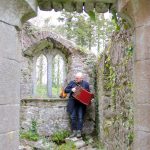AONAIR SOLO CD on the way!
For booking inquiries please contact: info@davidmunnelly.com
“Dave Munnelly takes the box to unimagined places simply by sitting down and playing”
Press Release Aonair. Launch: November 14th 2018
The title of the CD which means ‘alone’ or ‘solitary’, is a collection of new compositions by accordionist David Munnelly that were created and recorded over two days December 2017. As the title suggests, the CD contains ten solo pieces in which David shows his astonishing creativity on this diatonic instrument.
The origin of this project is also special as during the Christmas period of 2017 it was recorded in two days in the hall of De Parel van Zuilen, Utrecht where David lives.
Sounds, such as an espresso machine for the song ‘Corazon’. (the name of the coffee brand) air sounds and bellows ripples off the instrument are added to give a percussive backing. Malgosia Fiebig, the carrillonist of the famous Utrecht Cathedral, was so surprised by the pieces that she played one of the themes on the carrillon, which then ended up on this CD.
David’s background is traditional Irish music, but by experimenting with new sounds and musical styles for years, he has laid the foundation for his own original sound. Only the fact that he brings these tunes to life with one instrument, makes this a CD that is completely original.
____________ _________________ __________________ ____________ _____________ __________________ __________________
Alex Monaghan, Irish Music Magazine
Some nice things said:
David Munnelly “Aonair”
Appel Rekords, 2018
Aonair means alone, lonesome, a single soul, and that’s exactly what you get here. Button box innovator Munnelly puts his heart and soul into this recording, a minimalist one-man performance filled with passion and panache. Like several recent Irish albums, Aonair uses all the possibilities of the instrument – mechanical noises, percussive noises, the full suck-squeeze-bang-blow of an accordion engine, but Munnelly has also included ambient sounds and carillon recordings from his adopted home in Utrecht. This collection switches from right to left hand, from straight musical notes to sound effects and field recordings, with a degree of improvisation in many cases. I should also mention the brilliant sleeve design, inspired in its simplicity, with sleevenotes that are literally on the button.
Make no mistake – despite Dave’s Mayo roots, this is not traditional Irish music. There are elements of Ireland here – alongside elements of France, the Netherlands, Scandinavia, and most of Western European music from the Middle Ages to modern times. Transparent is perhaps the most recognisable piece for traditionalists, a jazzy waltz breaking into a reel before its structure shatters like a glass heart. Much of the rest of Aonair is difficult to describe, full of twists and turns, constantly in flux: a Parisian chanson here, a Gregorian chant there, a breathless run through a Spanish fiesta, snatches of hornpipe or march, melodies moving from box to voice and back again, all wrapped up neatly with a bow. It’s as though Munnelly has opened a door into his mind, allowed us to watch the flickering creativity play out for forty minutes or so, and then closed the portal again. Fascinating. © Alex Monaghan FOLKWORLD.EU
____________ _________________ __________________ ____________ _____________ __________________ __________________
´The great Irish box player David Munnelly never ceases to surprise.
For many years we have been enjoying the traditional music from his home country,
which he interpretes with great feeling and a virtuose technique; but currently Dave is presenting us
his latest compositions, in which he opens up new sonoric landscapes for the diatonic button accordion, exploring to the fullest the harmonic range and the rythmical possibilities of his instrument.
His buttons, reeds and bellows, which always keep sounding so very Irish at heart, reach out to other musical worlds and cultures.
David takes you with him on the ferry from Ireland, embarking on a wonderful music trip; his music breathes
the joy and sadness of life, changing between lots of energy and moments of deep reflection.
I truly hope you will enjoy his music as I do, or, even better, see David live on stage!´ Carel Kraayenhof, Bandoneonist
____________ _________________ __________________ ____________ _____________ __________________ __________________
Since 2010 I have had the good fortune and the pleasure of sharing the stage with Dave Munnelly in the Samurai project. From the first moment I was impressed by the naturalness and fluidity of his phrasing, the irresistible groove and impeccable technique. Dave plays traditional Irish music like few others, he is a true virtuoso of this style but at the same time also a modern and curious musician, with a great desire to experiment with new sounds and take his music farther
With this solo diatonic accordion album Dave gives us a series of new compositions where he pushes the expressive possibilities of the instrument to the maximum revealing a great compositional talent and an innate sense of melody. Riccardo Tesi, Accordionist
Solo
The Concert consists of playing mainly new music composed by myself for the Irish system Button Accordion and also reworkings of old melodies.
I have gone to great lengths to devise ways on playing melodies to their fullest sound on the instrument while using as much of it as i can.
Bigoraphy:
Calling David Munnelly a box player is – like calling Muhammad Ali a boxer – true but reductive. Of course, as someone who grew up playing traditional music, he plays Irish dance tunes in the style of a box player, and he plays them with a flare and level of mastery you’d expect from someone as talented and dedicated to the music as he is. However, from a young age, driven by an innate musical curiosity and rapidly acquired fluency, Munnelly began pushing his chosen instrument further than most to discover what more it could do, what more it could help him to say. So, more accurately, Munnelly plays the accordion in its fullest international sense. He has absorbed how the instrument is played in many different cultures by many different players, and he has developed his very own way of handling all those influences in his playing, particularly in his almost baroque bass note self-accompaniment. His sound is unmistakably him, but with a deep respect for many other masters coming through, from John J Kimmel to Máirtín O Connor to Riccardo Tesi. He has also come up against the limitations of his instrument in terms of its relatively mechanical nature, and with scientific dedication to perfecting the possible ornamentations, he has made a virtue of those limitations, able to make it sing as freely as many more tactile instruments in other hands.
But if we’re to fully honour his art, we need to say that David Munnelly simply makes music, irrespective of instrument, in the most individual sense. As a musical ear, Munnelly might be said to have always been somewhat restless. He might have heard something in a phrase of a dance tune, for instance, and in his own time followed it wherever it was willing to take him and soon made something completely new from it. His compositional urges – originally expressed as such improvisations and flourishing because of his powerful phrasing and tasteful dynamics – have been unleashed in recent years such that much of his solo music is now uncategorisable; each composition presenting a different musical narrative or drama and covering a variety of moods, often large and ambitious in scope. Paul O Connor








